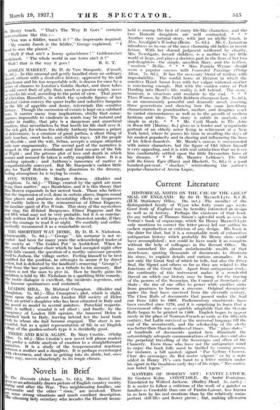Current Literature
HISTORICAL NOTES ON THE USE OF THE GliE‘T SEAL OF ENGLAND. By Sir H. Maxwell-byte, K.C.13; (H.M. Stationery Office. 18s. net.)—The member of the distinguished family of Wyon who forty years ago wrote. Great Seals of England was by heredity interested in design as well as in history. Perhaps the existence of that book (to say nothing of Thomas Simon's splendid work as seen in Vertue's book of engravings, which Sir fierily Maxwell-byte only mentions to correct the letter press) led our author to eschew reproduction or criticism of any design. His book is, the drier for that, but it is a remarkable work of exhaustive antiquarian history which probably Sir Henry alone could have accomplished ; nor could he have made it so complete without the help of colleagues in the Record Office. Ile has ransacked the almost unfathomable wealth of that Storehouse, quoting thousands of documents to illustrate his story, to explain details and curious anomalies. It is not only the Great Seal of which he tells, but also the Privy Seal, the Signet and others so far as they are related to the functions of the Great Seal. Apart, from antiquarian study, the continuity of this instrument makes it a wonderful thread on which our history may be hung, for the tracing Of the powers of the Sovereign, the Council or Secretaries of State ; the rise of one office to power while another sinks from greatness to become a sinecure. Original documents Under the Seal have survived from the eleventh century. The Close Rolls of documents that passed under the Seal run from 1204 to 1908. Parliamentary enactments have been enrolled since 1278, and it is surprising to learn that a Government office was so quickly adaptable that the Statute Rolls began to be printed in 1489. English began to appear rarely in the place of Norman-French as early as the fifteenth century, but Latin survived as the universal language till the end of the seventeenth, and the scholarship of the clerks was better then than in mediaeval times. The " place-dates of hundreds of documents quoted here. illuminate the astonishingly adequate communications of those days and also the perpetual travelling of the Sovereigns and often or the Chancery. Even those who have not the antiquarian mind to enjoy the book fully must be thrilled by coming across, for instance, a bill quoted, signed " Par Geffray Chaucer, Clore des oevereiges du Roi nostre seignia," or by a note added in Henry IV's own hand to a letter written under his signet in the troublous early days of his reign, " Neseseitas non habet legem."






























































 Previous page
Previous page